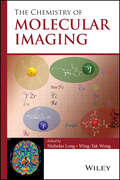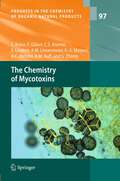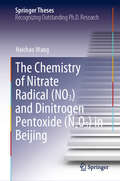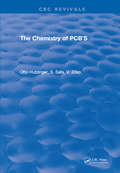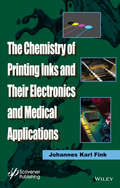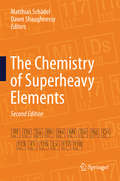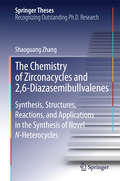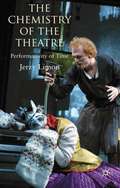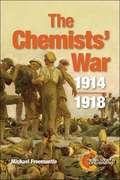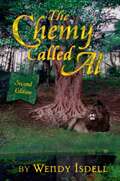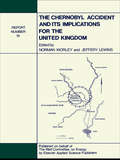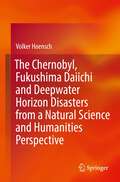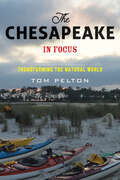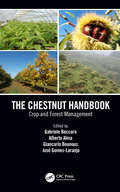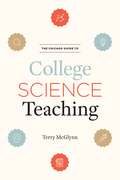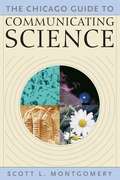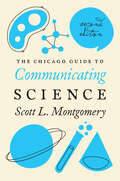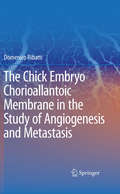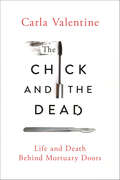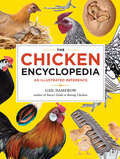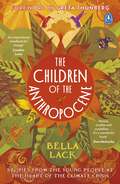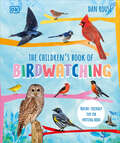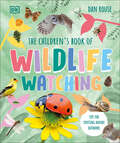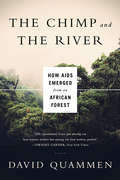- Table View
- List View
The Chemistry of Molecular Imaging
by Wing-Tak Wong Nicholas LongCovering all the fundamentals of modern imaging methodologies, including their techniques and application within medicine and industry, The Chemistry of Molecular Engineering focuses primarily on the chemistry of probes and imaging agents, as well as chemical methodology for labelling and bioconjugation. Written by an interdisciplinary team of experts, this book investigates the chemistry of molecular imaging and helps to educate non-chemists already involved in the area of molecular imaging. It addresses all the major modalities and techniques, such as MRI, positron emission tomography, single photon emission computed tomography, ultrasound, and fluorescence/optical imaging.
The Chemistry of Mycotoxins
by Stefan Bräse Anna M. Linsenmeier Stephanie Lindner Bettina M. Ruff Sabilla Zhong Franziska Gläser Carsten Kramer Anne C. Meister Kye-Simeon MastersThe biological activity of mycotoxins ranges from weak and/or sometimes positive effects, such as antibacterial activity (see penicillin derivatives derived from Penicillium strains) to strong mutagenic (e. g. aflatoxins, patulin), carcinogenic (e. g. aflatoxins), teratogenic, neurotoxic (e. g. ochratoxins), nephrotoxic (e. g. fumonisins, citrinin), hepatotoxic, and immunotoxic (e. g. ochratoxins, diketopiperazines) activity. Nowadays, many laboratories around the world are specialized in the detection of mycotoxins in food products and contaminated material found in housing. In this volume, a focus on the most important classes of mycotoxins is provided and their chemistry of the last ten years is discussed. In each Section, the individual biological impact is outlined. Sections are arranged according to mycotoxin classes (e. g. aflatoxins) and/or structural classes (e. g. resorcinyl lactones, diketopiperazines). The biology of mycotoxins is also described.
The Chemistry of Nitrate Radical (Springer Theses)
by Haichao WangThis book systematically describes the instrument setup for the measurement of nitrate radical (NO3) and dinitrogen pentoxide (N2O5), as well as the mixing ratio, chemical behaviors, and atmospheric impacts of NO3 and N2O5 in Beijing, China. It also discusses the instrument design and data analysis method in detail. Based on several field measurements of NO3 and N2O5 in Beijing, it shows the variation in concentration and the budget of NO3 and N2O5. The N2O5 heterogeneous uptake coefficient was determined using various methods, and the relationship between the N2O5 uptake coefficient and the particle properties was demonstrated, as well as the impact of NO3–N2O5 chemistry to the atmospheric oxidation and the formation of particulate nitrate. These results increase our understanding of nighttime chemistry and provide insights into the role of NO3–N2O5 chemistry in other polluted regions.
The Chemistry of PCB'S
by Otto HutzingerThe literature on chlorinated biphenyl is growing rapidly. Review articles on PCB's cited in this book usually contained a section on the toxicity of PCB. The structure and nomenclature are detailed. The chapters and topics included are (1) commercial PCB preparations: properties and compositions, (2) synthesis of chlorobiphenyls, (3) chemical reactions of chlorobiphenyls, (4) photodegradation of chlorobiphenyls, (5) metabolism of chlorobiphenyls, (5) mass spectroscopy of chlorobiphenyls, (6) nuclear magnetic resonance of chlorobiphenyls, (7) ultraviolet spectroscopy of chlorobiphenyls, (8) infrared spectrometry of chlorobiphenyls, (9) determination of chlorobiphenyls, and (10) recent developments.
The Chemistry of Printing Inks and Their Electronics and Medical Applications
by Johannes Karl FinkThis book focuses on the chemistry of inkjet printing inks, as well to special applications of these materials. As is well-documented, this issue has literallyexploded in the literature in particular in the patent literature.After an introductory section to the general aspects of the field, the types and uses of inkjet printing inks are summarized followed by an overview on the testing methods. Special compounds used as additives dyes, and pigments in inkjet printing inks are documented.The applications to the medical field - drug delivery systems, tissue engineering, bioprinting in particular - are detailed. The applications in the electronics industry are also documented such as flexible electronics, integrated circuits, liquid crystal displays, along a description of their special inks.The book incorporates many structures of the organic compounds used for inkjet printing inks as they may not be familiar to the polymer and organic chemists.
The Chemistry of Superheavy Elements
by Matthias Schädel Dawn ShaughnessyThe second edition of "The Chemistry of the Superheavy Elements" provides a complete coverage of the chemistry of a series of elements beginning with atomic number 104 - the transactinides or superheavy elements - including their nuclear properties and production in nuclear reactions at heavy-ion accelerators. The contributors to this work include many renowned scientists who, during the last decades, have made vast contributions towards understanding the physics and chemistry of these elusive elements, both experimentally and theoretically. The main emphasis here is on demonstrating the fascinating studies involved in probing the architecture of the Periodic Table at its uppermost end, where relativistic effects drastically influence chemical properties. All known chemical properties of these elements are described together with the experimental techniques applied to study these short-lived man-made elements one atom-at-a-time. The status of theoretical chemistry and of empirical models is presented as well as aspects of nuclear physics. In addition, one chapter outlines the meanderings in this field from a historical perspective and the search for superheavy elements in Nature.
The Chemistry of Zirconacycles and 2,6-Diazasemibullvalenes
by Shaoguang ZhangIn this thesis, the author introduces two strategies used to construct various types of N-heterocycles, based on the chemistry of zirconacycles and 2,6-diazasemibullvalenes. In the first part, the author presents the development of multi-component cyclization of a zirconacyclobutene-silacyclobutene fused compound, nitriles and unsaturated compounds. These reactions provide synthetically useful methodology for various N-heterocycles such as 3-acyl pyrrole, pyrrolo[3,2-d]pyridazine and dihydropyrroloazepine, which are all difficult to synthesize by other means. The isolation and characterization of the key three-fused-ring Zr/Si-containing intermediates are also described in detail. These results show that the zirconacyclobutene-silacyclobutene fused compound behaves as a "chemical transformer" upon treatment with various substrates via the "coordination-induced skeleton rearrangement" mechanism. In the second part, the author demonstrates the synthesis and isolation of a series of 2,6-diazasemibullvalenes (NSBVs) from the reaction of 1,4-dilithio-1,3-dienes and nitriles, highlighting the significant progress made for the first time in this work: (1) determination of X-ray crystal structure of a substituted 2,6-diazasemibullvalene; (2) measurement of the activation barrier of its rapid intramolecular aza-Cope rearrangement in solution; (3) exploration of several reaction types of NSBV with diverse ring-expansion products and "bowl-shape" or "cage-shape" N-containing polycyclic skeletons; (4) demonstration of the localized structure as the predominant form and the homoaromatic delocalized structure as a minor component in the equilibrium using theoretical analysis. Based on well-founded results, this work sheds new light on this controversial topic.
The Chemistry of the Theatre
by Jerzy LimonThis innovative, theoretical work focuses on temporal issues in theatre and the 'chemistry' of theatre - the ways in which a variety of factors in performance combine to make up what we call 'theatre'. Discussing a range of canonical plays, from Shakespeare to Beckett, the book makes a unique contribution to theatre and performance studies.
The Chemists' War: 1914-1918
by Michael FreemantleWithin months of the start of the First World War, Germany began to run out of the raw materials it needed to make explosives. As Germany faced imminent defeat, chemists such as Fritz Haber and Carl Bosch came to the rescue with Nobel Prize winning discoveries that overcame the shortages and enabled the country to continue in the war. Similarly, Britain could not have sustained its war effort for four years had it not been for chemists like Chaim Weizmann who was later to become the first president of the State of Israel. Michael Freemantle tells the stories of these and many other chemists and explains how their work underpinned and shaped what became known as The Chemists' War. He reveals: * how chemistry contributed to the care of the sick and wounded and to the health and safety of troops; * how coal not only powered the war but was also an important source of the chemicals needed for the manufacture of explosives, dyes, medicines and antiseptics; * how Britain's production of propellants relied on the slaughter of tens of thousands of whales; * how a precious metal played a critical role in the war; * how poisonous chemicals were used as weapons of mass destruction for the first time in the history of warfare and how chemists developed gas masks for protection against these weapons; * how the British naval blockade of Germany imperilled agricultural production in the United States. The book will appeal to the general reader as well as the many scientists and historians interested in the Great War.
The Chemostat: Mathematical Theory of Microorganism Cultures
by Alain Rapaport Claude Lobry Jérôme Harmand Tewfik SariInvented by J. Monod, and independently by A. Novick and L. Szilard, in 1950, the chemostat is both a micro-organism culturing device and an abstracted ecosystem managed by a controlled nutrient flow. This book studies mathematical models of single species growth as well as competition models of multiple species by integrating recent work in theoretical ecology and population dynamics. Through a modeling approach, the hypotheses and conclusions drawn from the main mathematical results are analyzed and interpreted from a critical perspective. A large emphasis is placed on numerical simulations of which prudent use is advocated. The Chemostat is aimed at readers possessing degree-level mathematical knowledge and includes a detailed appendix of differential equations relating to specific notions and results used throughout this book.
The Chemy Called Al
by Wendy IsdellSecond Edition, Paperback Back by popular request! Newly revised and expanded, this is the second edition of the popular sequel to the fiction title, "A Gebra Named Al" by Wendy Isdell. Julie finds herself lost once more in the land of Science, which borders Mathematics. With the help of some scientific horses and a mysterious lion, she learns about the roots of chemistry, the history of alchemy, and the four states of matter. Fiction, educational. 2nd release/glossy softcover. Recommended for ages 14 and up.
The Chernobyl Accident and its Implications for the United Kingdom: Watt Committee: report no 19
by Norman Worley Jeffery LewinsPublished on behalf of The Watt Committee on Energy
The Chernobyl, Fukushima Daiichi and Deepwater Horizon Disasters from a Natural Science and Humanities Perspective
by Volker HoenschIn our everyday imaginations we use the laws of nature with their tremendous possibilities of technical progress for the benefit of mankind. The three catastrophes of Chernobyl (26 April 1986), Fukushima Daichii (11 March 2011) and in the Gulf of Mexico, explosion of the drilling platform Deepwater Horizon (20 April 2010), have shaken this world view. Who directed this development? Is it a matter of human error or technical failure? For the answer, approaches from the natural sciences and the humanities are presented.
The Chesapeake in Focus: Transforming the Natural World
by Tom PeltonThe people, policies, and forces transforming a national treasure—the Chesapeake Bay.When Captain John Smith arrived in Virginia in 1607, he discovered a paradise in the Chesapeake Bay. In the centuries that followed, the Bay changed vastly—and not for the better. European landowners and enslaved Africans slashed, burned, and cleared the surrounding forests to grow tobacco. Watermen overfished oysters, shad, and sturgeon, decimating these crucial species. Baltimore, Washington, and Richmond used its rivers as urban sewers. By the 1960s, the Chesapeake was dying.A crossroads of life and culture, the Chesapeake straddles the North and the South, mixes salt water with fresh, and is home to about 18 million people and 3,600 species of animals and plants. Although recent cleanup efforts have improved its overall health, they have not been enough to save this national treasure. In The Chesapeake in Focus, award-winning writer Tom Pelton examines which environmental policies have worked and which have failed. Based on Pelton’s extensive experience as a journalist and as the host of the public radio program The Environment in Focus, this sweeping book takes readers on a tour of the histories of the Chesapeake, as well as the ecological challenges faced by its major tributaries. It details the management of blue crabs, striped bass, and other delicious wildlife, profiles leaders and little-known characters involved in the restoration campaign, and warns of the dangers of anti-regulatory politics that threaten to reverse what has been accomplished. Looking to the future, Pelton offers a provocative vision of the hard steps that must be taken if we truly want to save the Bay.
The Chestnut Handbook: Crop & Forest Management
by Gabriele Beccaro Alberto Alma Giancarlo Bounous Jose Carlos LaranjoChestnut Management and Production shares achievements in chestnut development and cultivation including information on sustainable planning and management of chestnut production from nursery to plantation, entomology, pathology, and ecosystem services. Cultivation techniques of Chinese, Japanese, and European chestnut species including hybrids are described containing information on over 550 local and commercial cultivars. Beautiful original handmade drawings and technical sheets facilitate accessibility and comprehension of information.
The Chicago Guide to College Science Teaching (Chicago Guides To Academic Life Ser.)
by Terry McGlynnHigher education is a strange beast. Teaching is a critical skill for scientists in academia, yet one that is barely touched upon in their professional training—despite being a substantial part of their career. This book is a practical guide for anyone teaching STEM-related academic disciplines at the college level, from graduate students teaching lab sections and newly appointed faculty to well-seasoned professors in want of fresh ideas. Terry McGlynn’s straightforward, no-nonsense approach avoids off-putting pedagogical jargon and enables instructors to become true ambassadors for science. For years, McGlynn has been addressing the need for practical and accessible advice for college science teachers through his popular blog Small Pond Science. Now he has gathered this advice as an easy read—one that can be ingested and put to use on short deadline. Readers will learn about topics ranging from creating a syllabus and developing grading rubrics to mastering online teaching and ensuring safety during lab and fieldwork. The book also offers advice on cultivating productive relationships with students, teaching assistants, and colleagues.
The Chicago Guide to Communicating Science
by Scott L. MontgomeryThis book offers detailed, practical advice on crafting every sort of scientific communication, from research papers and conference talks to review articles, interviews with the media, e-mail messages, and more.
The Chicago Guide to Communicating Science: Second Edition (Chicago Guides to Writing, Editing, and Publishing)
by Scott L. MontgomeryFor more than a decade, The Chicago Guide to Communicating Science has been the go-to reference for anyone who needs to write or speak about their research. Whether a student writing a thesis, a faculty member composing a grant proposal, or a public information officer crafting a press release, Scott Montgomery’s advice is perfectly adaptable to any scientific writer’s needs. This new edition has been thoroughly revised to address crucial issues in the changing landscape of scientific communication, with an increased focus on those writers working in corporate settings, government, and nonprofit organizations as well as academia. Half a dozen new chapters tackle the evolving needs and paths of scientific writers. These sections address plagiarism and fraud, writing graduate theses, translating scientific material, communicating science to the public, and the increasing globalization of research. The Chicago Guide to Communicating Science recognizes that writers come to the table with different needs and audiences. Through solid examples and concrete advice, Montgomery sets out to help scientists develop their own voice and become stronger communicators. He also teaches readers to think about their work in the larger context of communication about science, addressing the roles of media and the public in scientific attitudes as well as offering advice for those whose research concerns controversial issues such as climate change or emerging viruses. More than ever, communicators need to be able to move seamlessly among platforms and styles. The Chicago Guide to Communicating Science’s comprehensive coverage means that scientists and researchers will be able to expertly connect with their audiences, no matter the medium.
The Chick Embryo Chorioallantoic Membrane in the Study of Angiogenesis and Metastasis
by Domenico RibattiThe chick embryo chorioallantoic membrane (CAM) is an extraembryonic membrane which serves as a gas exchange surface and its function is supported by a dense capillary network. Because of its extensive vascularization and easy accessibility, the CAM has been broadly used to study the morpho-functional aspects of the angiogenesis process in vivo and to investigate the efficacy and mechanisms of action of pro-angiogenic and anti-angiogenic natural and synthetic molecules. The CAM is a suitable site for transplanting tissues, which can survive and develop in the CAM by peripheral anastomoses between graft and original CAM vasculature or by new angiogenic vessels grown from the CAM that invade the graft. While the formation of peripheral anastomoses between host and pre-existing donor vessels is the main, and the most common, mechanism involved in the revascularization of embryonic grafts, the growth of CAM-derived vessels into the graft is only stimulated in tumor grafts. The CAM has long been a favored system for the study of tumor angiogenesis and metastasis, because at this stage the chick immunocompetence system is not fully developed and the conditions for rejection have not been established. Tumors remain avascular for 72 h, after which they are penetrated by new blood vessels and begin a phase of rapid growth. Also, delivery of tumor cells onto the CAM allows the fine study of the effects of tumor derived angiogenic growth factors on blood vessel structure and functionality. The CAM may also used to verify the ability to inhibit the growth of capillaries by implanting tumors onto the CAM and by comparing tumor growth and vascularization with or without the administration of an anti-angiogenic molecule. Other studies using the tumor cells/CAM model have focused on the invasion of the chorionic epithelium and the blood vessels by tumor cells. The cells invade the epithelium and the mesenchymal connective tissue below, where they are found in the form of a dense bed of blood vessels, which is a target for intravasation.
The Chick and the Dead: Life and Death Behind Mortuary Doors
by Carla ValentineA mortician explains the autopsy process—and what it can teach us about the living—with “a morbidly galloping parade of every possible kind of dead body” (New York Times).Carla Valentine works with the dead. After studying forensics, she assisted pathologists with post-mortems for years before becoming the curator of the world’s most famous pathology museum. When it comes to death, she truly is an expert, and in this book she shares that expertise.Using the most common post-mortem process as the backbone of the narrative, she takes us through the process of an autopsy while also describing the history and changing cultures of our relationship with the dead. The book is full of vivid insight into what happens to our bodies in the end. Each chapter considers an aspect of an autopsy alongside an aspect of Carla’s own life and work, and touches on some of the more controversial aspects of our feelings about death, including the relationship between sex and death and our attitudes toward human tissue collection.Starting with the first cut, we move from external examination into the body itself, discovering more about the heart, stomach, and brain, and into dismembered and reconstructed bodies, at each stage taking a colorful detour into the question of what these things can teach us about the living. Join Carla on the journey from microscope-requesting nine-year-old to pathology educator and death engager at a Victorian museum (a journey made via around 5,000 autopsies) as she tells the story of exactly what it’s like to live a life immersed in death.Praise for Carla Valentine’s The Science of Murder“A breezy and accessible look at the history of forensic science.” —Publishers Weekly“Utterly superb.” —Deanna Raybourn, New York Times–bestselling author of the Veronica Speedwell Mysteries
The Chicken Encyclopedia: An Illustrated Reference
by Gail DamerowFrom addled to wind egg and crossed beak to zygote, the terminology of everything chicken is demystified in The Chicken Encyclopedia. Complete with breed descriptions, common medical concerns, and plenty of chicken trivia, this illustrated A-to-Z reference guide is both informative and entertaining. Covering tail types, breeding, molting, communication, and much more, Gail Damerow provides answers to all of your chicken questions and quandaries. Even seasoned chicken farmers are sure to discover new information about the multifaceted world of these fascinating birds.
The Children of the Anthropocene: Stories from the Young People at the Heart of the Climate Crisis
by Bella Lack'An inspirational manifesto for change' Caroline Lucas, former leader of The Green Party 'A remarkable and important book' Steve Backshall, Naturalist, Broadcaster, and Author'Astute, erudite and crystalline, Bella writes with visionary clarity and passion [...] It's a wonderful book' Dara McAnulty, award-winning author of Diary of a Young Naturalist____________________________Across the planet, the futures of young people hang in the balance as they face the harsh realities of the environmental crisis. Isn't it time we made their voices heard?The Children of the Anthropocene, by conservationist and activist Bella Lack, chronicles the lives of the diverse young people on the frontlines of the environmental crisis around the world, amplifying the voices of those living at the heart of the crisis.Advocating for the protection of both people and the planet, Bella restores the beating heart to global environmental issues, from air pollution to deforestation and overconsumption, by telling the stories of those most directly affected. Transporting us from the humming bounty of Ecuador's Choco Rainforest and the graceful arcs of the Himalayan Mountains, to the windswept plains and vibrant vistas of life in Altiplano, Bella speaks to young activists from around the world including Dara McAnulty, Afroz Shah and Artemisa Xakriabá, and brings the crisis vividly to life.It's time we passed the mic and listened to different perspectives. Bella's manifestos for change will inspire and mobilize you to rediscover the wonders and wilds of nature and, ultimately, change the way you think about our planet in crisis. This is your chance to hear the urgent stories of an endangered species too often overlooked: the children of the Anthropocene. ____________________________'Extraordinarily moving, wild and engaging - the book of the moment' Mary Robinson, Former President of Ireland and author of Climate Justice'A visionary statement for the future [...] Pragmatic, positive & beautifully written' Ben Macdonald, Award-Winning Conservation Writer, Wildlife TV Producer and Naturalist
The Children's Book of Birdwatching: Nature-Friendly Tips for Spotting Birds
by Dan RouseA fun, engaging birdwatching book for kids, full of information, activities, and tips on how to spot, identify, and care for birds. Make a difference to the local wildlife with hands-on activities, wonderful ideas and useful tips in this informative bird book for children. Make a bird feeder that you can fill with seeds, or a water bath for birds to drink from, and watch as a variety of birdlife gather! Young nature enthusiasts can enjoy this perfect introduction to animal conservation and protection, packed with engaging activities and plenty of advice from the brilliant bird expert and TV personality Dan Rouse. The Children&’s Book of Birdwatching celebrates local wildlife and teaches children about the challenges birds face and what we can do to help. Whether you love birds, enjoy gardening, or simply want to do your bit to help local wildlife, this delightful bird book is full of practical information and fun activities.This fascinating bird book for kids includes: - A delightful and simple introduction to birds and what we can do to help them.- Hands-on activities and upcycling projects for children to get involved in.- Informative and factual text accompanied by beautiful photographs and illustrations.- A range of projects that encourages children to enjoy spending time outdoors.Get to know birds with this handy guide, featuring craft activities to attract and help your feathered friends. Children aged 5-9 can discover ways to make their outdoor space more bird-friendly, from nurturing the right plants to deterring dangerous predators. Watch as they fly in for a visit! How many can you spot?
The Children's Book of Wildlife Watching: Tips for Spotting Nature Outdoors
by Dan RouseGet to know the wildlife in your garden with this handy guide, featuring craft activities to attract and help your outdoor friends.Make a difference to the local wildlife with the ideas and tips in this informative, hands-on book. Help the animals around you by creating a safe place where they can thrive. Discover how important these creatures are to the environment.Activities will help you get up-close to nature in a safe and responsible manner, whether it's by studying creepy-crawlies, pond dipping, or creating a mammal tracker. You can even design your own garden, with tips on planting the right plants to create a safe space for animals.With plenty of advice from the brilliant wildlife expert and TV personality Dan Rouse, this fun yet educational book is a perfect introduction to animal conservation and protection. The Children's Book of Wildlife celebrates local habitats and teaches children about the challenges animals face and what we can do to help. Whether you love nature, enjoy gardening, or simply want to do your bit to help local wildlife, this delightful book is full of practical information and fun activities.Soon you will know all about mammals, creepy-crawlies, amphibians, reptiles, and birds, and their needs. Watch as they visit your local area! How many animals can you spot?
The Chimp and the River: How AIDS Emerged from an African Forest
by David QuammenIn this "frightening and fascinating masterpiece" (Walter Isaacson), David Quammen explores the true origins of HIV/AIDS. The real story of AIDS--how it originated with a virus in a chimpanzee, jumped to one human, and then infected more than 60 million people--is very different from what most of us think we know. Recent research has revealed dark surprises and yielded a radically new scenario of how AIDS began and spread. Excerpted and adapted from the book Spillover, with a new introduction by the author, Quammen's hair-raising investigation tracks the virus from chimp populations in the jungles of southeastern Cameroon to laboratories across the globe, as he unravels the mysteries of when, where, and under what circumstances such a consequential "spillover" can happen. An audacious search for answers amid more than a century of data, The Chimp and the River tells the haunting tale of one of the most devastating pandemics of our time.
